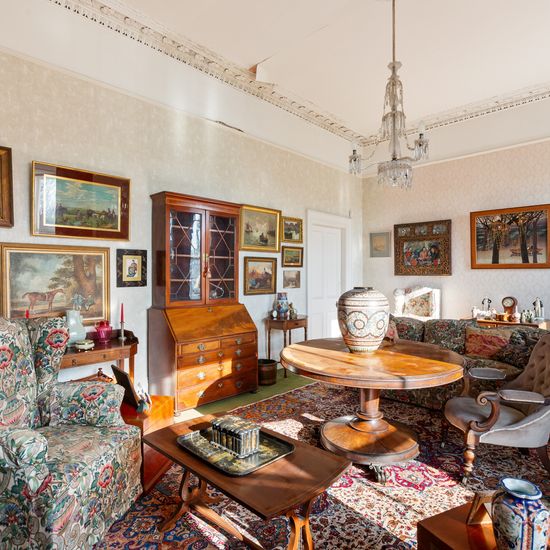By Eleanor Flegg
It is in the nature of collections to be dispersed for auction. Most are removed, photographed, and shown in the auction rooms where each lot is seen, as it is sold, on its own merits.
But things are far more interesting in the home from which they came, where their context adds another layer of meaning. The collector’s presence is everywhere – the grouping, positioning and display of objects is a story in itself.
The auction of the Estate of the late Philip Murphy takes place at Sheppard’s Auction Rooms in Durrow, Co Laois on July 15 and 16, but the lots are on view in their original home – 6 Royal Terrace West, Dun Laoghaire, Co Dublin, from Saturday, July 12 to Sunday, July 14. The collection is a journey back in time.
“My uncle lived in that house since the early 1960s,” says Hilary Walsh, Murphy’s niece and one of the executors.
“Once they bought the house, Philip and his wife Constance decided that everything in it should be correct and proper. They were diligent auction-goers. He was very knowledgeable and put a forensic level of detail into everything he collected. He had a good eye for when a piece had been interfered with.”
Royal Terrace East and West are Victorian, built in 1860 on opposite sides of a four-acre park. They were homes for wealthy Dubliners who travelled to and from the city on the Dublin to Kingstown railway.
As part of the Royal Terrace West Residents Association, Philip and Constance were instrumental in persuading Dún Laoghaire Borough Corporation to buy the square between the terraces from Monkstown Hockey Club in 1989.
“They were very involved in the presentation of the square,” Walsh says. “You wouldn’t want to be painting the railings the wrong colour.”
Inside the house, everything followed a Victorian aesthetic. The decor and furnishings are as true to the period as possible.
“The carpets are all in colours that would have been right for that period. Philip was very detail-oriented and interested in beautiful objects, but the house can be a little overwhelming,” Walsh admits. “Some of the antiques don’t fit so well into a 21st-century lifestyle and there’s too much stuff there for modern times.”
Although the house itself is in need of renovation, with Bakelite light switches and two-pin plugs, the collection was meticulously maintained.
As a child, Walsh remembers the smell of furniture polish. “You didn’t just pick up any furniture polish and silver cleaner in the supermarket. There was a correct way of doing it. He liked things done right. There was no sloppy cutting of corners.”
She also remembers the sound of many ticking clocks, all kept in full working order. “It was very atmospheric.”
As is the way with auctions, Philip Murphy’s collection has been interspersed with the possessions of “other important clients”. These have been displayed in keeping with the house contents and make for a more spectacular viewing, but also represent a dilution of the collection.
Murphy’s own collection includes a Georgian longcase clock by Gaskin of Dublin (Lot 313: est €500 to €800) and a host of carriage clocks.
Murphy had an interest in Killarney ware, a distinctive style of marquetry produced in the Killarney area in the 19th century.
Significant examples in the sale include a writing box with inlaid panels of Ross Castle and Muckross Abbey (Lot 512: est €800 to €1,200); a box in Irish yew wood with an inlaid interior and removable trays (Lot 509: €800 to €1,200); and a writing slope in yew wood, inlaid with shamrocks and a central view of Muckross Abbey (Lot 520: est €700 to €900). There are also many smaller pieces of Killarney ware in the sale.
The furniture in the kitchen is of a different style to the rest of the house, possibly reflecting the Irish country furniture Murphy might have remembered from his childhood in Dunmanway, Co Cork.
His father was the Labour politician TJ Murphy (1893-1949). These humble, vernacular pieces make a strong contrast with the ostentatious Victorian furniture upstairs.
They include a rustic pine settle bench (Lot 1048: est €200 to €300); a painted wooden armchair (Lot 1052: est €100 to €150); and a pine kitchen dresser (Lot 450: est €200 to €300).
See sheppards.ie
